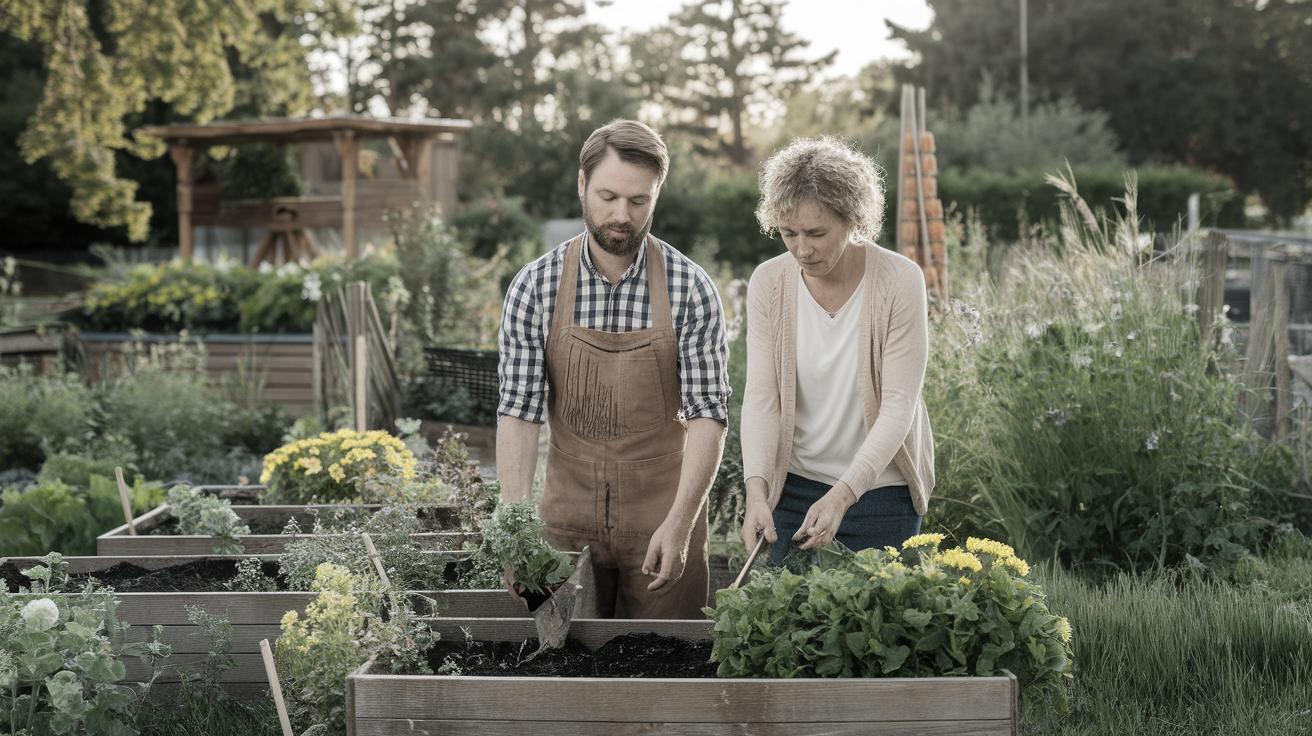Best Practices for Sustainable Gardening
Embarking on the journey of sustainable gardening not only elevates your home, but also contributes positively to the environment. This blog post will explore practices like going organic, reducing lawn space, utilizing native plants, and many others aimed at crafting a more eco-friendly green space. Whether you are a novice gardener or someone looking to refine your practices, these insights on sustainable gardening can help you create a thriving, self-sustaining ecosystem in your backyard. With each section, you’ll find practical tips that cater to various climate zones and yard sizes, fostering an enriching and more environmentally responsible gardening experience.
Go Organic
One of the cornerstones of sustainable gardening is the commitment to organic practices. By avoiding synthetic pesticides and fertilizers, you can preserve the soil’s natural structure and microorganism vitality. Organic gardening encourages a balanced ecosystem in which pests are kept under control naturally by predators and healthy plants are less susceptible to disease.
Implementing techniques such as crop rotation and composting provides a continuous replenishment of nutrients to your garden without the need for chemical interventions. Additionally, opting for organic seeds and plant varieties ensures that your gardening practices align with Earth-friendly principles. By going organic, you not only help the environment but also create a healthier harvest for yourself and your family.
Mulch Your Landscape
Mulching is an essential practice for anyone committed to sustainable gardening. By covering your soil with a layer of organic material such as wood chips, straw, or leaves, you can reduce water evaporation, suppress weeds, and enrich the soil as the mulch breaks down over time. This simple step helps maintain a more stable soil temperature and moisture level, promoting healthier plant growth.
Furthermore, mulch can enhance the aesthetic appeal of your garden while significantly reducing the need for frequent watering. Ensure that the mulch layer is not too thick, generally 2-3 inches, to avoid suffocating your plants. Utilizing locally sourced mulch can also reduce the carbon footprint associated with transporting garden materials.
Plant Natives
Incorporating native plants into your garden is a strategic way to promote sustainability. Native plants are naturally adapted to the local climate and soil conditions, and thus require less water, fertilizer, and pest control than non-native species. This means lower maintenance and reduced resource use, freeing up your time and conserving water and energy.
Native plants also support local wildlife, providing essential food and habitat for native insects, birds, and other animals. By choosing native species, you strengthen the local ecosystem and help preserve the plant biodiversity that is vital for environmental resilience.
Lose Your Lawn (Or Part of It)
Traditional lawns often consume a significant amount of resources, including water, fertilizer, and endless mowing. By reducing the size of your lawn or eliminating it entirely, you can save on these resources and convert the area into a more diverse and sustainable garden space.
Consider replacing portions of your lawn with native plant gardens, wildflower meadows, or vegetable plots. Not only will this decrease your environmental impact, but it also creates a more visually interesting and biodiverse landscape, supporting a larger variety of wildlife.
Water Less
Water conservation is a vital component of sustainable gardening. To reduce water usage, implement drought-tolerant plant choices and group plants with similar watering needs together in the garden. Drip irrigation systems and watering timers can also ensure that your garden receives the right amount of water without waste.
Additionally, collecting rainwater using barrels or other systems can provide a free and eco-friendly water source for your garden. Mulching and appropriate plant spacing further aid in conserving moisture within the soil, promoting a thriving garden even in dry conditions.
Grow Your Own Food
Growing your own food is a rewarding aspect of sustainable gardening. It reduces reliance on industrial agriculture, which often involves pesticides, herbicides, and significant carbon emissions from transportation. With home-grown fruits, vegetables, and herbs, you ensure freshness and quality while reducing your carbon footprint.
Start small with a few easy-to-grow crops, and expand as you gain confidence and knowledge. Consider using heirloom varieties, which are often more resilient and flavorful. This practice not only feeds your family but also enhances your understanding of plant growth and gardening techniques.
Plant Perennials
Perennials are plants that live for more than two years and present numerous benefits for a sustainable garden. Unlike annuals, perennials do not need to be replanted each year, saving time, effort, and resources. They provide reliable cover year-round, reducing soil erosion and nutrient loss.
Perennial plants often have deeper root systems, allowing them to tap into deep soil moisture and nutrients, making them more resilient to drought conditions. By choosing a mix of flowering and foliage perennials, you can create a dynamic garden that evolves with the seasons while minimizing maintenance.
Save Seeds
Seed saving is an ancient practice that can contribute to a garden’s sustainability. By collecting seeds from your best plants, you ensure genetic diversity and adaptation to your specific growing conditions. This practice reduces the need to purchase new seeds every year and promotes self-reliance.
Preserving seeds can also help protect against the loss of plant biodiversity and the monopolization of seed markets by large corporations. With a little care, you can store viable seeds for future planting, ensuring a continuous cycle of growth and sustainability in your garden.
Start Composting
Composting is one of the most effective ways to enrich your soil and reduce waste. By turning kitchen scraps and yard waste into nutrient-rich compost, you create a natural fertilizer that enhances soil health and plant growth without synthetic chemicals.
A compost pile can be started in a simple bin or a designated area in your yard. Regularly adding and turning the pile ensures aerobic decomposition, promoting a rich, crumbly end-product. Composting not only reduces landfill waste but also supports a sustainable and productive garden environment.
Mow with an Electric or Manual Mower
If you have a lawn, mowing can be made more sustainable by using an electric or manual mower. These options produce fewer greenhouse gases than traditional gas mowers and are often quieter, contributing to noise pollution reduction.
Electric mowers, particularly battery-powered models, offer convenience and performance with minimal environmental impact. Manual reel mowers provide a workout while maintaining your lawn in a peaceful, eco-friendly manner. Both choices align with sustainable gardening initiatives by reducing reliance on fossil fuels.
Companion Planting
Companion planting involves growing certain plants together to enhance growth and production, deter pests, or provide other mutual benefits. This practice can boost productivity by optimizing space and resources, benefiting biodiversity in your garden.
For instance, planting basil alongside tomatoes can improve the flavor and growth of both crops, while marigolds can deter common garden pests. Thoughtful companion planting techniques can increase yields, reduce the need for chemical interventions, and create a harmonious plant community.
Support Pollinators
Pollinators such as bees, butterflies, and birds are essential for a thriving garden ecosystem. Supporting these important creatures can involve planting a variety of flowering plants that provide nectar and pollen throughout the growing season.
Minimizing pesticide use, providing habitats like bee houses, and maintaining a diverse plant environment help support a healthy pollinator population. By welcoming these beneficial creatures, you play an active role in fostering biodiversity and ecological balance in your garden.
Future Prospects
| Practice | Benefits |
|---|---|
| Go Organic | Preserves soil health, reduces chemicals |
| Mulch Your Landscape | Retains moisture, suppresses weeds |
| Plant Natives | Conserves resources, supports local wildlife |
| Lose Your Lawn | Decreases resources, increases biodiversity |
| Water Less | Conserves water resources |
| Grow Your Own Food | Reduces food miles, ensures freshness |
| Plant Perennials | Reduces maintenance, enhances resilience |
| Save Seeds | Promotes genetic diversity, reduces costs |
| Start Composting | Enhances soil health, reduces waste |
| Mow with an Electric or Manual Mower | Reduces emissions, quieter operation |
| Companion Planting | Increases yields, deters pests naturally |
| Support Pollinators | Enhances biodiversity, supports ecosystems |


